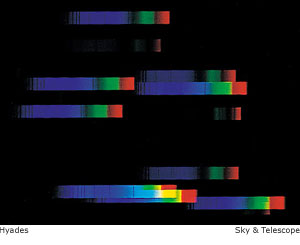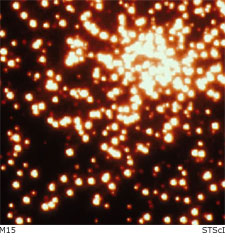
|
Syllabus Syllabus for printing - pdf Text: None! Notes, suggested readings on reserve in libraries, (hopefully on-line as well) Grading: Subject Matter, Goals, and Miscellaneous Comments What is it? Who am I speaking to? Astronomy 352K is a junior/senior-level introduction to stellar astronomy and astrophysics, with emphasis on observational and empirical methods for studying stars via the light they emit. It is designed mainly for upper-division astronomy majors, but it is also suitable for students majoring in closely related fields such as physics, mathematics, or engineering. Prerequisites? The prerequisites for AST 352K are Physics 316 (Electricity & Magnetism)
and its associated lab course Physics 116L, which have as their prerequisites
Physics 301 (Mechanics) and 101L, and relevant math courses.
It is acceptable to have taken instead the Engineering Physics courses
303K and 303L, with their lab courses.
Astronomy draws on such a wide variety of areas in physics that we cannot
expect you to have prior preparation in all of them, and so we will
introduce physical ideas and laws as needed.
(Examples include the theory of radiation, atomic structure, and
statistical mechanics.)
We will usually be interested mainly in applying physical principles,
rather than in deep and lengthy derivations, and in general the
mathematical manipulations expected of you (e.g., on
homework sets) will be pretty straightforward.
Background? We do not assume that you have strong (indeed, any!) previous background in astronomy, although many of the students will have previously taken other upper-division astronomy courses or at least had an introductory astronomy course such as AST~307 or 301. If you find that there are gaps in your basic astronomy knowledge, please ask me or the TA to explain or elaborate (either in class or during office hours). You might also find it helpful to consult one of the many fine introductory textbooks that are widely available (I can lend you one of them). It should take you only a few evenings to master all of the relevant material that is contained in these books. Overlap with other courses? There is a small amount of overlap between AST~352K and AST~358 (Galaxies and the Universe), AST~353 (Astrophysics), and AST~352L (Positional, Kinematical, and Dynamical Astronomy). We will try to avoid excessive redundancy, but that is inevitable in some subject areas, since not all members of the present class will have taken these other courses.
Your presentation? Students generally benefit from the experience of researching a
specific topic in some depth.
Toward the latter part of this course you will be asked to give a short
(10 minute) presentation on a topic that deals with some
interesting aspect of stellar astronomy.
Your presentation will be an oral explanation of a poster on the
subject that you have prepared for the occasion.
Your grade will be determined from a combination of astronomical content,
presentation style and effort, and the quality of the poster
that accompanies your presentation.
You will individually prepare and give this small talk on some
narrow stellar astronomy topic, but in the context of a broader topic to be
addressed by a group of students.
There will be three or four broad areas drawn from the latter topics
in the preliminary course outline given below, each of which will
be assigned to a group of three to five students.
The members of the group will work together to decide how to divide up
the larger topic into individual presentations, and will also serve as
a pool of informed people in the same general area, and can (ought to!)
provide an audience for "practice" presentations that (ought to!) take
place prior to the formal presentation in class.
Groups that work together well and give uniformly high-quality
presentations will get "bonus" points added to their grade, giving students
an incentive to help each other.
Your work will be posted to the class web site.
My bias in this course? I regard AST 352K as a vital link between the basic, often elegant physics and mathematics that you have ingested at UT for the past two-three years, and the real, often messy world of astronomical research. Astrophysics combines elements from all areas of physics to offer coherent theoretical models for how the solar system, galaxy, and universe are constructed and how they have and will evolve. If you are looking for that in this course, forget it. Theoretical astrophysics cannot really derive rational models for an object without appealing to observational astronomy. I am not an astrophysicist as the term is usually meant (that is, I am not a theorist). I am an observational astronomer, and proud of it. And observational astronomy is what you will find covered in this course. Not how is the universe constructed, but how does one practically assemble the basic data about particular astronomical objects (stars) that can be gainfully used in constructing the story of the universe?
Homework, and your approach to it? The homework sets are the keys to what I want to get done in this course.
I intend to be (perhaps irritatingly) vague in some of the assignments.
I admit this to be a totally deliberate ploy.
Real astronomical research usually does not admit cookbook
solutions to interesting problems, and I want you to get used to that.
Such an approach is also a signal on my part that I encourage interactions
with you outside class.
Feel free to discuss with me the course material, problem sets, or any
other astronomical topic that come to mind.
On the first page I give the formal office hours, but you of course
may set up appointments with me at other rational times of day.
Notice also that I give my work number, email address, and my home
phone number.
I prefer contact in person or a phone call; emails to me can get deeply
buried.
I would not give out my home phone number if I did not expect calls
in the evening whenever you need to.
(OK, it's true that we are the
only Snedens in the Austin telephone directory.)
I want to help you do well in this course, but I need you to make
contact!
Don't be shy: remember that the truly stupid question is the unasked one.
Caveat Emptor? I finish with two warnings, one applicable to all faculty members here and one specific to me. First, in this department you deal with professional astronomers. The good part is that you get very close to current research, and that can be very exciting. The bad part is that we tend to travel a lot (most obviously to observatories in remote and exotic locales), and I will need to excuse myself from class a couple of times during the semester. At present I have a trip scheduled for October 13-18 (missing class October 15, 17), and one November 5-7 (missing class November 7). However, all classes will meet. A substitute lecturer will pinch-hit for me in class on those occasions. Second, I am currently Letters Editor of The Astrophysical Journal. This means that inevitably I am pulled in many different teaching/service/research directions simultaneously, and frankly I am very busy. However, this should not become your problem! I expect you to work in this class, and you should expect no less of me. Do not feel the slightest hesitation in pushing me to make time for you outside of class; politely in the beginning, but more firmly if I do not respond. Your interaction in this course can only aid your understanding.
|
Astronomy Program · The University of Texas at Austin · Austin, Texas 78712
prospective student inquiries: studentinfo@astro.as.utexas.edu
site comments: www@www.as.utexas.edu
 Textbook? Nope. This is because I find no single text satisfactory enough to
justify asking you to spend $50-100.
Instead, I will put various texts on reserve in the Peridier
library, and I will recommend readings from them.
I will also post copies of my notes notes on your class web site.
I have alternated teaching this course with Prof. Harriet Dinerstein,
and between us we have pretty much settled on the topics and presentation
order that we like.
All credit for the most recent major upgrade in the class notes goes
to Harriet!
My version will not depart a lot from hers.
Textbook? Nope. This is because I find no single text satisfactory enough to
justify asking you to spend $50-100.
Instead, I will put various texts on reserve in the Peridier
library, and I will recommend readings from them.
I will also post copies of my notes notes on your class web site.
I have alternated teaching this course with Prof. Harriet Dinerstein,
and between us we have pretty much settled on the topics and presentation
order that we like.
All credit for the most recent major upgrade in the class notes goes
to Harriet!
My version will not depart a lot from hers.
 So forget cookbook problems? Not entirely, but we will deal as much as possible with real data from the
literature that have been obtained at various astronomical facilities
over the past decades, and which now are readily available for study.
Many of the homework problems will encourage you to seek data from
basic astronomical catalogs.
These sources can be found on web sites and in our Peridier Library,
to which we intend to introduce you if you have not already seen it.
However, a serious word needs to be given here.
The Peridier Library is NOT part of the general UT library system,
but is instead a part of the department and observatory research facility.
It is available to help you by providing materials for this course.
It is intended solely for the use of our faculty, staff, and research
students.
We invite you to begin integrating into our program with privileges
to the Peridier Library.
Please use this library moderately, quietly and with respect for others.
Think of your use of the Peridier Library as a guest membership
at a club, and please do not abuse it or overstay your welcome.
So forget cookbook problems? Not entirely, but we will deal as much as possible with real data from the
literature that have been obtained at various astronomical facilities
over the past decades, and which now are readily available for study.
Many of the homework problems will encourage you to seek data from
basic astronomical catalogs.
These sources can be found on web sites and in our Peridier Library,
to which we intend to introduce you if you have not already seen it.
However, a serious word needs to be given here.
The Peridier Library is NOT part of the general UT library system,
but is instead a part of the department and observatory research facility.
It is available to help you by providing materials for this course.
It is intended solely for the use of our faculty, staff, and research
students.
We invite you to begin integrating into our program with privileges
to the Peridier Library.
Please use this library moderately, quietly and with respect for others.
Think of your use of the Peridier Library as a guest membership
at a club, and please do not abuse it or overstay your welcome.